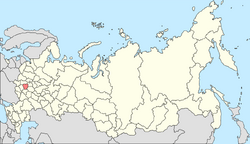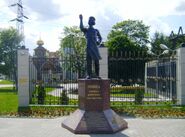| Tula Тула |
|||
|---|---|---|---|
| — City — | |||
| Tula Kremlin | |||
|
|||
| Location of Tula Oblast in the Russian Federation | |||
| Coordinates: Coordinates: | |||
| Country | Russia | ||
| Federal subject of Russia | Tula Oblast | ||
| Administrative center of | Tula Oblast | ||
| Urban okrug | Tula Urban Okrug | ||
| Established | 1146 | ||
| Government | |||
| • Type | Representative body | ||
| • Body | City Duma | ||
| • Mayor | Alisa Tolkachyova | ||
| Area | |||
| • Total | 145 km2 (56 sq mi) | ||
| Population (2010) | |||
| • Total | 501,129 | ||
| • Rank | 37 | ||
| Postal codes | 300000–300999 | ||
| Dialing code | 4872 | ||
| Website | http://www.tula.ru | ||
Tula (Russian: Ту́ла) is an industrial city and the administrative center of Tula Oblast, Russia. It is located 193 kilometers (120 mi) south of Moscow, on the Upa River. Population: 501,129 (2010 Census);[1] 481,216 (2002 Census);[2] 539,980 (1989 Census).[3]
History[]
The city has existed since at least the 14th century; the name is of pre-Russian, probably Baltic, origin.[4] In the Middle Ages, Tula was a minor fortress at the border of the Principality of Ryazan. As soon as it passed to Muscovy, a brick citadel, or kremlin, was constructed in 1530. It was a key fortress of the Great Abatis Belt and successfully resisted a siege by the Tatars in 1552. In 1607, Ivan Bolotnikov and his supporters seized the citadel and withstood a 4-months siege by the tsar's army. In the 18th century some parts of the kremlin walls were demolished. Despite its archaic appearance, the 5-domed Assumption Cathedral in the kremlin was built as late as 1764.
In 1712, Tula was visited by Peter the Great, who commissioned the Demidov blacksmiths to build the first armament factory in Russia. Several decades later, Tula was turned by the Demidovs into the greatest ironworking centre of Eastern Europe. The oldest museum in the city, showcasing the history of weapons, was inaugurated by the Demidovs in 1724, and Nicholas-Zaretsky Church in the city houses their family vault. The first factory to produce samovars industrially was also established there in the course of the 18th century. After the Demidovs moved the centre of their manufacture to the Urals, the city continued as a center of heavy industry, particularly in the manufacture of matériel.
During the Great Patriotic War (World War II) of 1941 to 1945, the city was important in the production of armaments (Rifle wise: Tula produced more SVT-40 rifles than Mosin-Nagant M91/30, M38, and M44 rifles). Tula became the target of a German offensive to break Soviet resistance in the Moscow area between October 24 and December 5, 1941. The heavily fortified city held out, however, and Guderian's Second Panzer Army was stopped near Tula. The city secured the southern flank during the battle of Moscow and the subsequent counter-offensive. Tula was awarded the title Hero City in 1976. It is home to Klokovo air base.
Culture[]
A musical instrument, the Tula accordion, is named for the city, which is a center of manufacture for such instruments sold throughout Russia and the world. Tula is also renowned for traditional Russian pryaniki (gingerbread), cookies made with honey and spices (see Tula gingerbread). In the West, Tula is perhaps best known as the center of samovar production: the Russian equivalent of "coals to Newcastle" is "You don't take a samovar to Tula".
The most popular tourist attraction in Tula Oblast is Yasnaya Polyana, the home and burial place of the writer Leo Tolstoy. It is situated fourteen kilometers south-west of the city. It was here that Tolstoy wrote his celebrated novels War and Peace and Anna Karenina.
Education[]
Tula is home to:
- Tula State University
- Tula State Pedagogical University [1]
- The Tula artillery and Engineering Institute
- A branch of the All Russia Economic and Finance Institute
- A branch of The Moscow Economics and Management Institute
Transport[]
Tula is a major railway junction with trains to Moscow, Orel, Kursk and Kaluga. The Moscow to Simpheropol M2 motorway runs past the city. City transport is presented by trams, trolleybuses, buses and marshrutkas. Tula trams, trolleybuses and 14 of 26 bus routes are operated by "Tulgorelectrotrans" (Tula city electrotransport company), other 12 bus routes are operated by "Tulaavtotrans" (Tula automobile transport company).
Sport[]
In Russian fist fighting Tula was considered to have some of the most famous fighters.[5][6]
The city football club, FC Arsenal Tula, plays in the Russian Amateur League.
International relations[]
Twin towns/sister cities[]
Tula is twinned with:[7]
Gallery[]
References[]
- ^ "Всероссийская перепись населения 2010 года. Том 1 [2010 All-Russian Population Census, vol. 1)]" (in Russian). Всероссийская перепись населения 2010 года (2010 All-Russia Population Census). Federal State Statistics Service. 2011. http://www.gks.ru/free_doc/new_site/perepis2010/croc/perepis_itogi1612.htm. Retrieved June 29, 2012.
- ^ "Численность населения России, субъектов Российской Федерации в составе федеральных округов, районов, городских поселений, сельских населённых пунктов – районных центров и сельских населённых пунктов с населением 3 тысячи и более человек [Population of Russia, its federal districts, federal subjects, districts, urban localities, rural localities—administrative centers, and rural localities with population of over 3,000]" (in Russian). Всероссийская перепись населения 2002 года (All-Russia Population Census of 2002). Federal State Statistics Service. May 21, 2004. http://www.perepis2002.ru/ct/doc/1_TOM_01_04.xls. Retrieved February 9, 2012.
- ^ Demoscope Weekly (1989). "Всесоюзная перепись населения 1989 г. Численность наличного населения союзных и автономных республик, автономных областей и округов, краёв, областей, районов, городских поселений и сёл-райцентров. [All Union Population Census of 1989. Present population of union and autonomous republics, autonomous oblasts and okrugs, krais, oblasts, districts, urban settlements, and villages serving as district administrative centers]" (in Russian). Всесоюзная перепись населения 1989 года (All-Union Population Census of 1989). Institute of Demographics of the State University—Higher School of Economics. http://demoscope.ru/weekly/ssp/rus89_reg.php. Retrieved February 9, 2012.
- ^ E.M. Pospelov, Geograficheskie nazvaniya mira (Moscow: Russkie slovari, 1998), p. 423: "The earliest etymologies derived the place name from Russian dialectal tulá 'hidden, unreachable place'... The pre-Russian origin of the name of the river and town is no longer doubted [Maiorova 1985].... Since the name of the river Upa is certainly Baltic..., its tributary *Tula [the presumed earlier form of Tulitsa] may also be of Baltic origin, which is supported by a series of parallels in Lithuanian toponymy: the river Tule, the Tulis swamp, the Tulyte field, the meadow Tulejos, the valley Tulija, etc. [Vanagas, 1981]; the meaning of these toponyms is not entirely clear...."
- ^ Русский кулачный бой: "Tula's fighters were always glorious, but every place had its heroes."
- ^ Сказания о русских народных играх "Tula's fighters were considered the best one on one."
- ^ "Црпй "Рскю" / Бяецн Рпх Онапюрхлю Рскш Нярюкняэ Б Лхпе". Tula.rfn.ru. 2005-04-29. http://tula.rfn.ru/rnews.html?id=2673&cid=9. Retrieved 2009-11-24.
External links[]
Template:Cities and towns in Tula Oblast

















